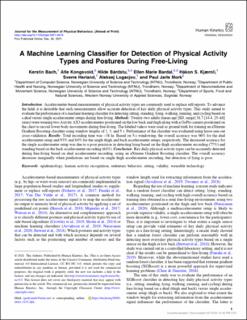| dc.description.abstract | Accelerometer-based measurements of physical activity types are commonly used to replace self-reports. To advance the field, it is desirable that such measurements allow accurate detection of key daily physical activity types. This study aimed to evaluate the performance of a machine learning classifier for detecting sitting, standing, lying, walking, running, and cycling based on a dual versus single accelerometer setups during free-living. Methods: Twenty-two adults (mean age [SD, range] 38.7 [14.4, 25–68] years) were wearing two Axivity AX3 accelerometers positioned on the low back and thigh along with a GoPro camera positioned on the chest to record lower body movements during free-living. The labeled videos were used as ground truth for training an eXtreme Gradient Boosting classifier using window lengths of 1, 3, and 5 s. Performance of the classifier was evaluated using leave-one-out cross-validation. Results: Total recording time was ∼38 hr. Based on 5-s windowing, the overall accuracy was 96% for the dual accelerometer setup and 93% and 84% for the single thigh and back accelerometer setups, respectively. The decreased accuracy for the single accelerometer setup was due to a poor precision in detecting lying based on the thigh accelerometer recording (77%) and standing based on the back accelerometer recording (64%). Conclusion: Key daily physical activity types can be accurately detected during free-living based on dual accelerometer recording, using an eXtreme Gradient Boosting classifier. The overall accuracy decreases marginally when predictions are based on single thigh accelerometer recording, but detection of lying is poor. | en_US |

